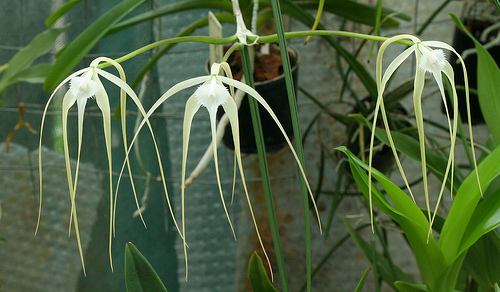From the Community: Birds, bees, bats, beer and biofuels
A process of producing biofuels that yields brewer’s yeast, researchers’ evidence that human neurodegenerative disorders in Guam in the 1960s were linked to cyanobacteria, President Obama shows support for synthetic biology research and scientists track migratory birds at their farthest recorded distance. Here are highlights in ecology for the last week in May.
Orchid pollination: Researchers tagged orchid bees in Panama with radio transmitters to measure their distance and speed, a feat that has not been accomplished before. The bees were found to “fly up to 3 miles from their home areas and patrol up to 285 acres of rainforest in their hunt for food and mates.” Read more at “Radio-Tracking Orchid Bees in Panama” or view the video.
Beer and biofuels: Researchers from Michigan State University explore a more efficient way to convert second-generation feedstocks into bioethanol. One method, which ferments the sugar breakdown with yeast derived from the gut of insects, produces 300 liters of biofuel from one metric ton of plant material and yields a plentiful supply of brewer’s yeast as a by-product. Read more at “Biofuels learn to eat less.”
Tricky antelopes: Certain male antelopes in southwest Kenya have been shown to fake a fear response to rouse females in heat. By eliciting a special snort (pretending predators were observed), the males induced the females to stay close to the male for security, thus allowing the males more time for a mating opportunity. Read more at “Male Antelopes Fake Fear To Have Sex.”
Bioconcentration: Controversial research suggests that the spike in neurodegenerative disorders in Chamarros, natives of Guam, in the 1960s was being caused by the bioconcentration of BMAA, a toxin from cyanobacteria inhabiting cycad roots. Chamarros, many of whom ate flour derived from cycad seeds as well as cycad-seed-eating native bats, had a spike in disorders at the same time as the bat populations were falling to endangered levels. Read more at “A Batty Hypothesis on the Origins of Neurodegenerative Disease Resurfaces.”
Bio boom: The Obama administration showed interest in synthetic biology research after a panel review on the subject convened last week. According to a Wired.com article, “The House committee members seemed primarily interested in the potential of synthetic biology to create micro-organisms that could effectively produce hydrocarbons that could be used to power the nation’s transportation system.” Read more at “Congress, Obama Take Sudden Interest in Synthetic Biology.”
Also, a mystery fossil turns out to be an ancestor of the modern-day squid, Ug99 stem rust runs rampant in Africa’s wheat fields, honeybee colonies are fighting both fungal and viral invaders, scientists create a canoe (Rimicanoe) inspired by the eyeless hydrothermal vent shrimp Rimicaris exoculata and researchers tracking bar-tailed godwits discovered a migration route spanning 7,100 miles that is traversed in just nine days.
Photo credit: petrichor
